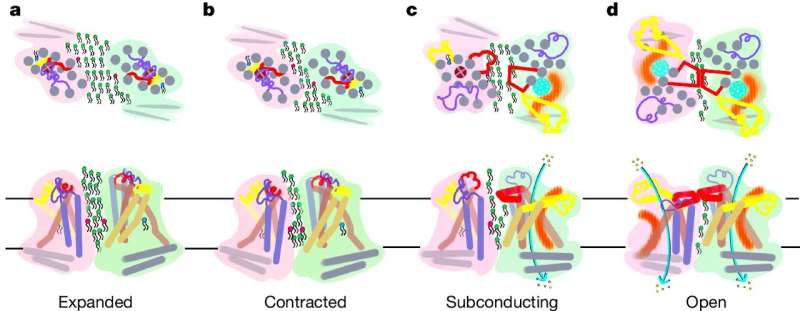This article has been reviewed according to Science X's editorial process and policies. Editors have highlighted the following attributes while ensuring the content's credibility:
fact-checked
peer-reviewed publication
trusted source
proofread
'Force-sensing' protein could better treat diseases that cause seizures

Researchers from The Australian National University (ANU) have made a discovery about a little understood protein in the human body that could help treat diseases that cause seizures, including epilepsy. The study is published in Nature.
The researchers examined the "force-sensing" protein, or mechanical protein, which is responsible for physical touch and brain development.
The under-researched protein is part of the family that enables us to feel mechanical forces, such as touch and hearing, which are converted into nerve impulses that can be interpreted by the brain.
The researchers found that by understanding more about the force-sensing protein, diseases such as hypomyelination, where the sheath around nerve cells does not develop properly and makes it hard for the brain to send nerve impulses, resulting in severe developmental delays and epileptic seizures, could be better treated.
"By knowing more about how the force-sensing protein works, it opens the door to try to develop therapeutic opportunities to help people with these conditions," Professor Ben Corry, from ANU, said.
"In diseases such as hypomyelination, the body cannot produce myelin—the substance insulating the nervous system's electrical wires—at normal levels."
The ANU scientists discovered that these proteins work completely differently from other sensing proteins we already know about.
According to Professor Corry, the way that protein molecules sense a change in the cell membrane to open up a pore—which allows matter in and out of the cell and is what starts the neuronal signal—was behaving differently from similar proteins.
"The unexpected discovery was that this force-sensing protein behaved completely differently from other similar proteins," Professor Corry said.
"In this case, it was half formed by the protein and half by the cell membrane itself. This is something unheard of for us biologists."
Through scientific experiments, the researchers found that the cell membrane helps control what goes in and out of cells in response to these mechanical forces.
"Our experiments showed how and what can go in and out of the cell can be altered by changing the membrane, not the protein molecule itself," Professor Corry said.
"We've shown that these proteins work in a completely different way from other sensing proteins. This is important because they could be playing some quite unexpected roles that are yet to be determined.
"For example, this novel mechanism might mean that they have a role in wound healing, where, in a way, they're being used to signal things happening in your cell membranes that are not necessarily directly related to these forces."
Professor Corry said these force-sensing proteins are also found in other species, including plants.
"Plants have an almost identical force sensor, so they can distribute and pull water up from the roots and move it to the leaves. Better understanding this could contribute to the development of salt-tolerant plants for agricultural use," Professor Corry said.
While the researchers were studying healthy cells, they said the next step would be to look at what's happening on the cellular level to people with diseases with poor myelination of neurons.
"After considering the disease condition, there might be direct medical implications, including finding ways to treat it," Professor Corry said.
More information: Yaoyao Han et al, Mechanical activation opens a lipid-lined pore in OSCA ion channels, Nature (2024). DOI: 10.1038/s41586-024-07256-9
Journal information: Nature
Provided by Australian National University





















